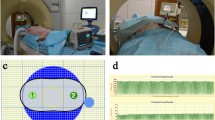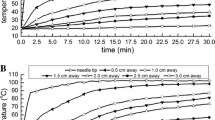Abstract
The aim of this study was to compare the effects of percutaneous radiofrequency ablation (RFA) combined with percutaneous acetic acid injection (PAI) and either therapy alone for their effects on in vivo rabbit liver tissue. Thirty New Zealand white rabbits were included in this study and were allocated to three groups: group A, conventional RFA (n=10); group B, PAI (n=10); and group C, combined RFA and PAI (n=10). Under US guidance, 1 ml of 50% acetic acid was injected into the target area of the liver parenchyma through a 21-G Chiba needle before performing RFA. The RFA was then performed using a 17-G internally cooled electrode with 1-cm active tip, and RF energy (30 W) was applied for 3 min with or without acetic acid injection. After RFA or PAI, contrast-enhanced CT and CT pathologic correlation were performed. The maximum diameters of the thermal lesions in each group were compared. All procedures were technically successful, and a total of 30 lesions (10 lesions for each group) were produced. The mean maximum diameter of the coagulation necrosis in the rabbits of group C (25±9 mm) was significantly larger than the diameters of the other groups: 12.2±1 mm (group A) and 14.3±3 mm (group B; p=0.001). On contrast-enhanced CT scanning, the lesions of group B (7 of 10, 70%) appeared frequently irregular compared with those of groups A (2 of 10, 20%) and C (4 of 10, 40%; p=0.08). There were seven complications (23.3%): a localized hematoma in a group-A rabbit; two hematomas and one chemical peritonitis in group-B rabbits; and a hematoma, a chemical peritonitis, and a burn injury to the stomach in group-C rabbits. Compared with the group-A rabbits (1 of 10, 10%), the group-B (3 of 10, 30%) and group-C rabbits (3 of 10, 30%) showed a tendency toward complications, but the difference was not significant (p=0.48). Under the present experimental condition, combined RFA and PAI was able to increase the diameter of coagulation necrosis up to 2.5 cm without significantly increasing complications.


Similar content being viewed by others
References
Gazelle GS, Goldberg SN, Solbiati L, Livraghi T (2000) Tumor ablation with radio-frequency energy. Radiology 217:633–646
Lim HK (2000) Radiofrequency thermal ablation of hepatocellular carcinomas. Korean J Radiol 1:175–184
McGahan JP, Dodd GD III (2001) Radiofrequency ablation of the liver: current status. Am J Roentgenol 176:3–16
Solbiati L, Livraghi T, Ierace T, Meloni F, Goldberg SN (2000) Local control of focal liver malignancies treated with RF ablation: initial report of the Italian Multicenter Cooled-tip RF Study Group (Abstract). Radiology 217 (Suppl):27
Ahmed M, Goldberg SN (2002) Thermal ablation therapy for hepatocellular carcinoma. J Vasc Interv Radiol 13:S231–S243
Dupuy DE, Goldberg SN (2001) Image-guided radiofrequency tumor ablation: challenges and opportunities—part II. J Vasc Interv Radiol 12:1135–1148
Rossi S, Stasi M di, Buscarini E, Quaretti P, Garbagnati F, Squassante L, Paties CT, Silverman DE, Buscarini L (1996) Percutaneous RF interstitial thermal ablation in the treatment of hepatic cancer. Am J Roentgenol 167:759–768
Livraghi T, Goldberg SN, Meloni F, Solbiati L, Gazelle GS (1999) Hepatocellular carcinoma: comparison of efficacy between percutaneous ethanol instillation and radiofrequency. Radiology 210:655–663
Livraghi T, Goldberg SN, Lazzaroni S, Meloni F, Ierace T, Solbiati L, Gazelle GS (2000) Hepatocellular carcinoma: radiofrequency ablation of medium and large lesions. Radiology 214:761–768
Ni Y, Miao S, Mulier S, Yu J, Baert AL, Marchal G (2000) A novel “cooled-wet’’ electrode for radiofrequency ablation. Eur Radiol 10:852–854
Miao Y, Ni Y, Yu J, Zhang H, Baert A, Marchal G (2001) An ex vivo study on radiofrequency tissue ablation: increased lesion size by using an “expandable-wet” electrode. Eur Radiol 11:1841–1847
Miao Y, Ni Y, Yu J, Marchal G (2000) A comparative study on validation of a novel cooled-wet electrode for radiofrequency liver ablation. Invest Radiol 35:438–444
Lee JM, Youk JH, Kim YK, Han YM, Chung GH, Lee SY, Kim CS (2003) Radiofrequency thermal ablation with hypertonic saline solution injection of the lung: ex vivo and in vivo feasibility studies. Eur Radiol 13:2540–2547
Rossi S, Garbagnati F, Lencioni R, Allgaier HP, Marchiano A, Fornari F, Quaretti P, Tolla GD, Ambrosi C, Mazzaferro V, Blum HE, Bartolozzi C (2000) Percutaneous radiofrequency thermal ablation of nonresectable hepatocellular carcinoma after occlusion of tumor blood supply. Radiology 217:119–126
Goldberg SN, Kruskal JB, Oliver BS, Clouse ME, Gazelle GS (2000) Percutaneous tumor ablation: increased coagulation by combining radiofrequency ablation and ethanol instillation in a rat breast tumor model. Radiology 217:827–831
Ohnishi K, Ohyama N, Ito S, Fujiwara K (1994) Small hepatocellular carcinoma: treatment with US-guided intratumoral injection of acetic acid. Radiology 190:53–57
Haaga JR (1994) Interventional CT-guided procedures. In: Haaga JR, Lanzieri CF (eds) Computed tomography and magnetic resonance imaging of the whole body, 3rd edn. Mosby Year-Book, St. Louis, pp 1572–1693
Goldberg SN, Gazelle GS, Comptom CC, Mueller PR, Tanabe KK (2000) Treatment of intrahepatic malignancy with radiofrequency ablation. Cancer 88:2452–2463
Lee JD, Lee JM, Kim SW, Kim CS, Mun WS (2001) MR imaging—histopathologic correlation of radiofrequency thermal ablation lesion in a rabbit liver model: observation during acute and chronic stages. Korean J Radiol 2:151–158
Char CH, Lee FT, Gurney JM, Markhardt BK, Warner TF, Kelcz F, Mahvi DM (2000) CT vs sonography for monitoring radiofrequency ablation in a porcine liver. AJR 175:705–711
Shiina S, Tagawa K, Niwa Y, Unuma T, Komatsu Y, Yoshiura K, Hamada E, Takahashi M, Shiratori Y, Terano A (1993) Percutaneous ethanol injection therapy for hepatocellular carcinoma: results in 146 patients. Am J Roentgenol 160:1023–1028
Livraghi T, Giorgio A, Martin G, Salmi A, Sio I de, Bolondi L, Pompili M, Brunello F, Lazzaroni S, Torzilli G (1995) Hepatocellular carcinoma and cirrhosis in 746 patients: long-term results of percutaneous ethanol injection. Radiology 197:101–108
Buscarini L, Buscarini E, Stasi M di, Vallisa D, Quaretti P, Rocca A (2001) Percutaneous radiofrequency ablation of small hepatocellular carcinoma: long-term results. Eur Radiol 11:914–921
Goldberg SN, Gazelle GS (2001). Radiofrequency tissue ablation: physical principles and techniques for increasing coagulation necrosis. Hepatogastroenterology 48:359–367
Lencioni R, Cioni D, Donati F, Bartolozzi C (2001) Combination of interventional therapies in hepatocellular carcinoma. Hepatogastroenterology 48:8–14
Goldberg SN, Saldinger PF, Gazelle GS, Huertas JC, Stuart KE, Jacobs T, Kruskal JB (2001) Percutaneous tumor ablation: increased coagulation necrosis with combined radiofrequency and percutaneous doxorubicin injection. Radiology 220:420–427
Patterson EJ, Scudamore CH, Owen DA, Nagy AG, Buczkowski AK (1998) Radiofrequency ablation of porcine liver in vivo: effects of blood flow and treatment time on lesion size. Ann Surg 227:559–566
Goldberg SN, Hahn PF, Halpern E, Fogle R, Gazelle GS (1998) Radiofrequency thermal ablation: effect of pharmacologic modulation of blood flow on coagulation diameter. Radiology 209:761–769
Ohnishi K, Yoshioka H, Ito S, Fujiwara K (1998) Prospective randomized controlled trial comparing percutaneous acetic acid injection and percutaneous ethanol injection for small hepatocellular carcinoma. Hepatology 27:67–72
Dodd GD, Frank MS, Aribandi M, Chopra S, Chintapalli KN (2002) Radiofrequency thermal ablation: computer analysis created by overlapping ablations. Am J Roentgenol 177:777–782
Acknowledgements
The authors thank L. So for her assistance in animal observation and anesthesia, and for her outstanding support in obtaining the CT images. We also thank B. Hami for her editorial assistance and manuscript preparation.
Author information
Authors and Affiliations
Corresponding author
Rights and permissions
About this article
Cite this article
Lee, J.M., Lee, Y.H., Kim, Y.K. et al. Combined treatment of radiofrequency ablation and acetic acid injection: an in vivo feasibility study in rabbit liver. Eur Radiol 14, 1303–1310 (2004). https://doi.org/10.1007/s00330-003-2140-0
Received:
Revised:
Accepted:
Published:
Issue Date:
DOI: https://doi.org/10.1007/s00330-003-2140-0




